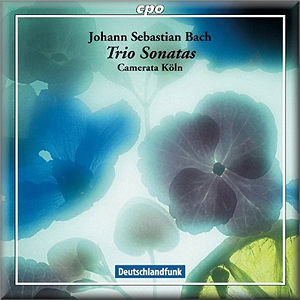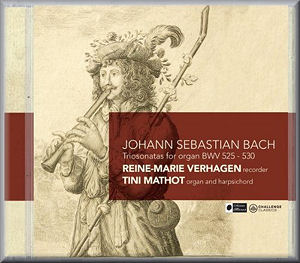 |
 |
| 

alternatively
CD: MDT
AmazonUK
AmazonUS
Sound
Samples & Downloads
|
Johann Sebastian BACH
(1685 - 1750)
Trio Sonatas
Sonata in g minor (BWV 1029) [14:42]
Sonata in D (BWV 1028) [13:48]
Sonata in G (BWV 1027) [12:31]
Sonata in g minor (orig in d minor) (BWV 527) [13:02]
Sonata in G (orig in E flat) (BWV 525) [13:08]
 Camerata Köln - Karl Kaiser (transverse flute), Michael Schneider
(recorder, voice flute), Sabine Lier, Ingeborg Scheerer (violin),
Rainer Zipperling, Julianne Borsodi (viola da gamba), Yasunori Imamura
(theorbo), Sabine Bauer (harpsichord, organ)
Camerata Köln - Karl Kaiser (transverse flute), Michael Schneider
(recorder, voice flute), Sabine Lier, Ingeborg Scheerer (violin),
Rainer Zipperling, Julianne Borsodi (viola da gamba), Yasunori Imamura
(theorbo), Sabine Bauer (harpsichord, organ)
rec. 20-23 September 2006, chamber music auditorium, Deutschlandfunk,
Cologne, Germany. DDD
 CPO 777 359-2 [67:35]
CPO 777 359-2 [67:35] 
|


alternatively
CD: MDT
AmazonUK
AmazonUS
Sound
Samples & Downloads |
Johann Sebastian BACH
(1685-1750)
Trio sonatas for organ BWV 525-530
Sonata IV (BWV 528)* [09:14]
Sonata V (BWV 529) [13:30]
Sonata II (BWV 526)* [10:38]
Sonata I (BWV 525) [10:25]
Sonata VI (BWV 530)* [12:03]
Sonata III (BWV 527) [11:41]
 Reine-Marie Verhagen (recorder, voice flute), Tini Mathot (harpsichord,
organ*)
Reine-Marie Verhagen (recorder, voice flute), Tini Mathot (harpsichord,
organ*)
rec. May 2008, Waalse Kerk, Amsterdam, Netherlands. DDD
 CHALLENGE CLASSICS CC72314 [67:36]
CHALLENGE CLASSICS CC72314 [67:36]  |
| |
In the early stages of historical performance practice arrangements
of baroque music were regarded as suspect. That was understandable
as at that time such arrangements were mostly romantic distortions
of what the composers had in mind. Over the years performers
came to understand that arrangements were a common phenomenon
in the baroque era, and that composers themselves frequently
arranged their own compositions.
The oeuvre of Johann Sebastian Bach bears witness to this. In
particular his instrumental music as we know it is made up in
large part of arrangements or adaptations of some kind. The
harpsichord concertos were originally written for other solo
instruments, like violin or oboe, and many sonatas are also
re-workings of pieces in other scorings. The growing understanding
of this practice has led performers to follow Bach's example
and rework his music. On the one hand attempts are made to restore
them, as it were, to what could have been their original form.
On the other hand, musicians try to perform these works in new
scorings, which they hope will do justice to their character.
The three sonatas for viola da gamba and obbligato harpsichord
are often the subject of re-workings and adaptations.
Camerata Köln has recorded them with two melody instruments
and basso continuo. It is fortunate that Bach himself has given
an insight into his way of adapting his music: the Sonata
in G (BWV 1027) is also known in its previous scoring for
two transverse flutes and bc (BWV 1039). The first flute part
was given to the right hand of the harpsichord, the second was
set one octave lower and given to the viola da gamba. In this
recording the sonata is played with the first flute part from
BWV 1039 and the gamba part from BWV 1027, both unaltered, with
the basso continuo from BWV 1039. The two other gamba sonatas
are performed in a comparable manner. In the Sonata in g
minor (BWV 1029) the right hand of the harpsichord part
is played at the violin, the viola da gamba part remains unaltered,
and the left hand of the harpsichord is figured to be performed
as a basso continuo. The Sonata in D (BWV 1028) is performed
the same way; this time the upper part is given to the recorder.
The six trio sonatas for two manuals and pedal - usually performed
at the organ, but also playable at pedal harpsichord or pedal
clavichord - are unique in Bach's oeuvre. It is assumed they
were written as study material for Bach's eldest son Wilhelm
Friedemann, who would become a famous organist, very much of
the same calibre as his father. But it is also thought they
may be re-workings of trio sonatas for two melody instruments
and basso continuo. Whether that is true or not, over the years
ensembles have taken the opportunity to play them as such, with
various instruments in the treble parts. Camerata Köln has chosen
two from the set. These are transposed to another key in order
to make them playable at the transverse flute (BWV 525) or the
recorder (BWV 527). The second treble part is given in both
sonatas to the violin. The bass line of the organ is again figured
and played by the basso continuo group.
Camerata Köln has done a fine job in adapting these five sonatas
by Bach. They sound very well in these new scorings and are
quite faithful to the style of Bach's instrumental composition.
The playing is also very good, in a truly speech-like manner,
well phrased and articulated, and with fine dynamic gradation.
The performances are engaging; in this way the corpus of instrumental
music by Bach is considerably enhanced. One can easily think
of other scorings, but Camerata Köln's approach seems to me
a good model of how to approach the issue of adaptation.
The whole set of trio sonatas for organ has been recorded by
Reine-Marie Verhagen and Tini Mathot. Their approach is different
as they haven't really arranged the sonatas. I assume they have
been transposed, but that issue is not mentioned by Ms Mathot's
husband, Ton Koopman, in his liner-notes. The track-list doesn't
give any keys at all, which is a serious omission. Here the
sonatas are played as Bach wrote them, with the recorder taking
the right hand of the keyboard, and the harpsichord or the organ
playing the other two parts. Despite the fact that the sonatas
are not reworked the result is less convincing than Camerata
Köln's performances of the Sonatas 1 and 3 from the set. There
are various reasons for that.
Firstly, I am not really impressed by the playing of the two
artists. They are very fine musicians, but their approach is
too restrained. The addition of ornamentation is inconsistent:
there are many ornaments in the middle movement of the Sonata
III, for instance, but often very few in the fast movements.
The recorder's dynamic range is limited, but there is far too
little dynamic gradation here. In general the performances are
too flat and not very compelling.
The other issue is that the artists seem to be torn between
two ideas expressed in the use of organ and harpsichord as alternative
keyboard instruments. This leads to a quite different balance
between keyboard and recorder. Three of the sonatas are performed
with organ, and here the two instruments blend perfectly. In
fact, the recorder acts as one of the organ's stops. Unfortunately
the registration in some sonatas or movements, for instance
the Sonata II, is such that the two upper parts can hardly
be distinguished. As such there is nothing wrong with this approach.
And here the lack of dynamic gradation could be justified by
the fact that the organ can't make any dynamic shifts either.
In the three sonatas with harpsichord the role of the recorder
is quite different. It doesn't blend with the harpsichord in
the same way as with the organ. In these sonatas the recorder
takes the role of a true solo instrument, competing with the
harpsichord. That requires a different approach, but the performance
is the same as in the sonatas with organ. To me the approach
of these sonatas by Reine-Marie Verhagen and Tini Mathot seems
rather ambiguous.
Musically the sonatas with organ and recorder come off best.
Why should they be performed this way when they don't offer
any really new perspective? The performances with recorder and
harpsichord are basically more interesting, but these are musically
not really satisfying.
Johan van Veen
|
|

